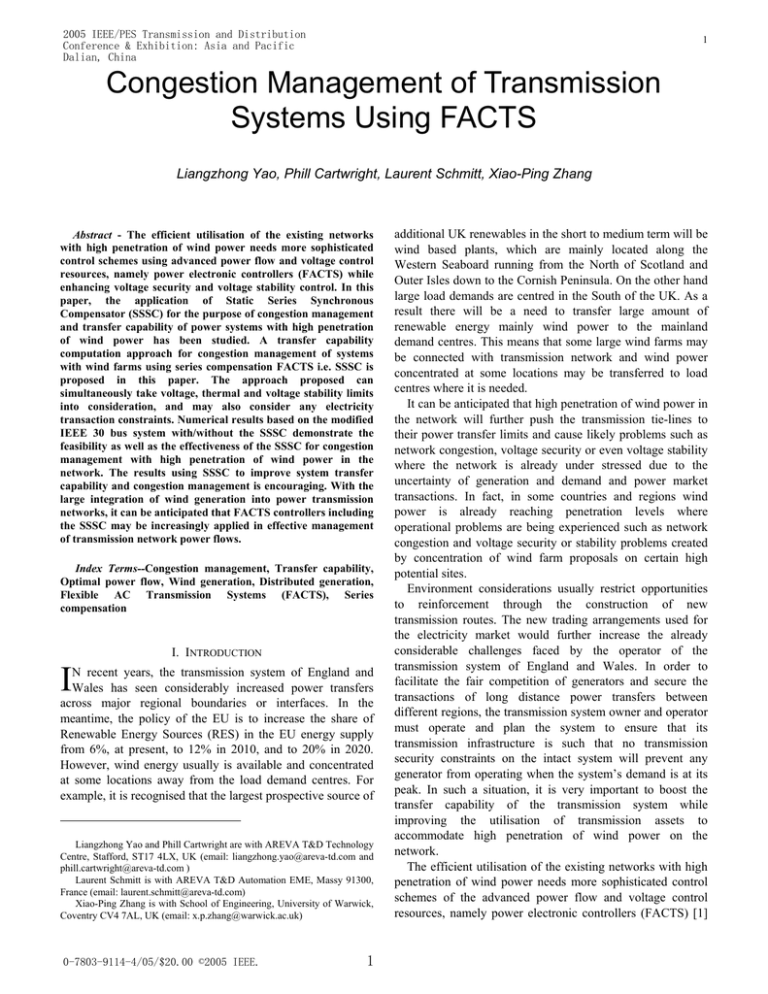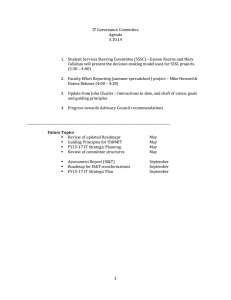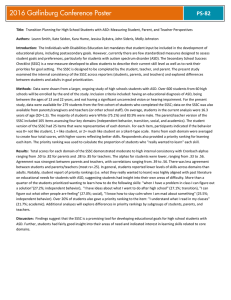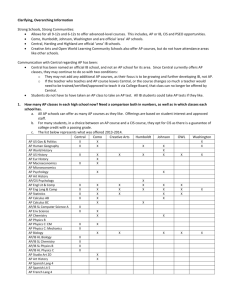wind+FACTS
advertisement

2005 IEEE/PES Transmission and Distribution
Conference & Exhibition: Asia and Pacific
Dalian, China
1
Congestion Management of Transmission
Systems Using FACTS
Liangzhong Yao, Phill Cartwright, Laurent Schmitt, Xiao-Ping Zhang
Abstract - The efficient utilisation of the existing networks
with high penetration of wind power needs more sophisticated
control schemes using advanced power flow and voltage control
resources, namely power electronic controllers (FACTS) while
enhancing voltage security and voltage stability control. In this
paper, the application of Static Series Synchronous
Compensator (SSSC) for the purpose of congestion management
and transfer capability of power systems with high penetration
of wind power has been studied. A transfer capability
computation approach for congestion management of systems
with wind farms using series compensation FACTS i.e. SSSC is
proposed in this paper. The approach proposed can
simultaneously take voltage, thermal and voltage stability limits
into consideration, and may also consider any electricity
transaction constraints. Numerical results based on the modified
IEEE 30 bus system with/without the SSSC demonstrate the
feasibility as well as the effectiveness of the SSSC for congestion
management with high penetration of wind power in the
network. The results using SSSC to improve system transfer
capability and congestion management is encouraging. With the
large integration of wind generation into power transmission
networks, it can be anticipated that FACTS controllers including
the SSSC may be increasingly applied in effective management
of transmission network power flows.
Index Terms--Congestion management, Transfer capability,
Optimal power flow, Wind generation, Distributed generation,
Flexible AC Transmission Systems (FACTS), Series
compensation
I
I. INTRODUCTION
N recent years, the transmission system of England and
Wales has seen considerably increased power transfers
across major regional boundaries or interfaces. In the
meantime, the policy of the EU is to increase the share of
Renewable Energy Sources (RES) in the EU energy supply
from 6%, at present, to 12% in 2010, and to 20% in 2020.
However, wind energy usually is available and concentrated
at some locations away from the load demand centres. For
example, it is recognised that the largest prospective source of
Liangzhong Yao and Phill Cartwright are with AREVA T&D Technology
Centre, Stafford, ST17 4LX, UK (email: liangzhong.yao@areva-td.com and
phill.cartwright@areva-td.com )
Laurent Schmitt is with AREVA T&D Automation EME, Massy 91300,
France (email: laurent.schmitt@areva-td.com)
Xiao-Ping Zhang is with School of Engineering, University of Warwick,
Coventry CV4 7AL, UK (email: x.p.zhang@warwick.ac.uk)
0-7803-9114-4/05/$20.00 ©2005 IEEE.
1
additional UK renewables in the short to medium term will be
wind based plants, which are mainly located along the
Western Seaboard running from the North of Scotland and
Outer Isles down to the Cornish Peninsula. On the other hand
large load demands are centred in the South of the UK. As a
result there will be a need to transfer large amount of
renewable energy mainly wind power to the mainland
demand centres. This means that some large wind farms may
be connected with transmission network and wind power
concentrated at some locations may be transferred to load
centres where it is needed.
It can be anticipated that high penetration of wind power in
the network will further push the transmission tie-lines to
their power transfer limits and cause likely problems such as
network congestion, voltage security or even voltage stability
where the network is already under stressed due to the
uncertainty of generation and demand and power market
transactions. In fact, in some countries and regions wind
power is already reaching penetration levels where
operational problems are being experienced such as network
congestion and voltage security or stability problems created
by concentration of wind farm proposals on certain high
potential sites.
Environment considerations usually restrict opportunities
to reinforcement through the construction of new
transmission routes. The new trading arrangements used for
the electricity market would further increase the already
considerable challenges faced by the operator of the
transmission system of England and Wales. In order to
facilitate the fair competition of generators and secure the
transactions of long distance power transfers between
different regions, the transmission system owner and operator
must operate and plan the system to ensure that its
transmission infrastructure is such that no transmission
security constraints on the intact system will prevent any
generator from operating when the system’s demand is at its
peak. In such a situation, it is very important to boost the
transfer capability of the transmission system while
improving the utilisation of transmission assets to
accommodate high penetration of wind power on the
network.
The efficient utilisation of the existing networks with high
penetration of wind power needs more sophisticated control
schemes of the advanced power flow and voltage control
resources, namely power electronic controllers (FACTS) [1]
2
V i = Vi ∠θ i V j = V j ∠θ j , then the power flow equations of
the SSSC can be established:
while enhancing voltage security and voltage stability control.
In this paper, we will in particular look at the application of
Static Series Synchronous Compensator (SSSC) [2] for the
purpose of congestion management and transfer capability of
power systems with high penetration of wind power. The
paper investigates and demonstrates how, at regional
transmission level, effective FACTS based power flow
control can be applied to relieve the transmission congestion
and improve the transfer capability of the network with high
penetration of wind power while voltage security and voltage
stability constraints are satisfied and transmission assets can
be effectively utilised.
Pij = V i 2 g ii − V iV j ( g ij cos θ ij + bij sin θ ij )
Qij = − Vi 2 bii − ViV j ( g ij sin θ ij − bij cosθ ij )
Pji = V j2 g jj − ViV j ( g ij cosθ ji + bij sinθ ji )
(3)
+ V jVse ( g ij cos(θ j − θ se ) + bij sin(θ j − θ se ))
Q ji = − V j2 b jj − ViV j ( g ij sin θ ji − bij cosθ ji )
(4)
+ V jVse ( g ij sin(θ j − θ se ) − bij cos(θ j − θ se ))
where
g ij + jbij = 1 / Z se
A. Modelling of SSSC
As shown in Fig. 1, a SSSC usually consists of a coupling
transformer, an inverter and a capacitor. However, the SSSC
is series connected with a transmission line through the
coupling transformer. Operation principle of a SSSC can be
found in [2]. In principle, the inserted series voltage can be
regulated to change the impedance (more precisely reactance)
of the transmission line. Therefore the power flow of
transmission line can be controlled.
V se
(2)
− ViVse ( g ij sin(θ i − θ se ) − bij cos(θ i − θ se ))
II. MODELLING OF FACTS CONTROLLERS
I ij
(1)
− V iV se ( g ij cos( θ i − θ se ) + bij sin( θ i − θ se ))
g ii = g ij
bii = bij
g jj = g ij
b jj = bij
Operating constraint of the SSSC (active power exchange
via the DC link) is:
PE = Re(V se I *ji )
= −ViV se ( g ij cos(θ i − θ se ) − bij sin(θ i − θ se ))
I ji
+ V j V se ( g ij cos(θ j − θ se ) − bij sin(θ j − θ se )) = 0
(5)
The equivalent voltage injection Vsh ∠θ sh bound constraints:
Vi
Vj
Vi
Z se
V se
Re{V se I *ji } = 0
(6)
min
max
θ se
≤ θ se ≤ θ se
(7)
B. Modelling of VSC HVDC
The success of application of VSC technologies in FACTS
has inspired interests to apply such technologies in HVDC
transmission. It was reported recently that VSC based HVDC
systems have been successfully installed in several electric
utilities in European Countries and U.S. However, it should
be pointed out that these HVDC systems are basically used
for back-to-back power transmission. The detail modeling of
the VSC HVDC in power flow and optimal power flow
analysis has been discussed in [4]. In comparison to the
SSSC, the VSC HVDC can provide independent active and
reactive power flow control and also bus voltage control. In
principle, the VSC HVDC should be more powerful than the
SSSC in terms of control capability.
Fig. 1. The schematic representation of SSSC
Pij + jQij
I ij Bus i
Vsemin ≤ Vse ≤ Vsemax
P ji + jQ ji
Bus j I ji
Vj
III. FORMULATION OF TRANSFER CAPABILITY
COMPUTATION PROBLEM INCLUDING FACTS AND
WIND FARMS
Fig. 2. The equivalent circuit of SSSC
A. Representation of Wind Farm
In the transfer capability calculations, a wind farm at the
connection point can be equivalently represented by active
and reactive power injections Pwind and Qwind with a
The equivalent circuit of a SSSC as shown in Fig. 2 can be
derived based on the operation principle of the SSSC.
According to the equivalent circuit, suppose V se = Vse ∠θ se ,
constant power factor:
2
3
Pwind = αP 0
wind
(8)
Qwind = αQ 0
wind
(9)
⎡− Πl −1 Sl
− ∇h
0
0 ⎤ ⎡ ∆πl ⎤
⎢
⎥⎢
⎥
−1
Πu Su − ∇h
0 ⎥ ⎢∆πu ⎥
⎢ 0
⎢ − ∇h T
H
− ∇h T
− J T ⎥ ⎢ ∆x ⎥
⎢
⎥⎢
⎥
−J
0
0 ⎥⎦ ⎣ ∆λ ⎦
⎢⎣ 0
0
0
and Qwind
are base case active and reactive
where Pwind
power injections of the wind farm while Pwind and Qwind are
the actual active and reactive power injections as functions of
the load increase parameter. α represents the load increase
factor.
⎡ − ∇ πl Lµ − Πl ∇ Sl Lµ ⎤
⎥
⎢
− ∇ L − Πu −1∇ Su Lµ ⎥
= ⎢ πu µ
⎥
⎢
− ∇ x Lµ
⎥
⎢
− ∇ λ Lµ
⎥⎦
⎢⎣
B. Representation of Load
A load in the transfer capability calculations is defined by
(10)
Pd k = α * Pd k0
Qd k = α * Qd k0
(11)
∆sl = Πl −1 (∇ sl Lµ − Sl∆πl )
(16)
∆su = Π u (−∇ su Lµ − Su∆πu )
(17)
−1
k ∈ Ωk
where
µ - barrier parameter and µ > 0
sl and su are slack variables for inequalities. πl and πu are
dual variables for inequalities. λ are dual variables for
equalities
where
Pd k0 , Qd k0 - base case active and reactive load of bus k
Pd k , Qd k - active and reactive load of bus k
Ω k - a set of buses which have variable loads
H ( x, λ , πl ,πu )
= ∇ 2 f ( x) − λ∇ 2 g ( x) − (πl + πu )∇ 2 h( x)
⎡ ∂∆P( x) ∂∆Q( x) ⎤
J ( x) = ⎢
,
∂x ⎥⎦
⎣ ∂x
⎡ ∆P( x) ⎤
g ( x) = ⎢
⎥
⎣∆Q( x)⎦
C. Formulation of Transfer Capability Computation Problem
Mathematically, the transfer capability may be formulated
as,
Objective:
Max f (x ) = α
(12)
Subject to the following constraints:
g ( x) = 0
(13)
h min ≤ h( x) ≤ h max
(15)
−1
(14)
⎡λ p ⎤
⎥
⎣ λq ⎦
Sl = diag ( sl j )
λ=⎢
where x = [θsh,Vsh,V ,θ , T , Pg , Qg ,α ]
T
Pij - sum of the interface active power flows
Ω I - the set of the interface tie lines
Su = diag ( su j )
g(x) - equality constraints including bus power flow
equations, operating and control constraints with
incorporation of the FACTS controllers
h(x) - inequality-constraints including line flow constraints,
simple inequality constraints of variables such as
voltage-magnitudes, generator active power, generator
reactive power, transformer tap ratio and bound
constraints of SSSC variables, wind farm reactive
power injections and load increase factor
θse - angle of series voltage source of SSSC
Vse - magnitude of series voltage source of SSSC
θ - bus angle
V - bus voltage magnitude
T - tap ratio vector of transformer
Pg - bus active generation
Qg - bus reactive generation
α -load increase parameter
The nonlinear optimisation problem of the transfer
capability in (12) – (14) can be solved by the Nonlinear
Interior Point Methods [3]. The Newton equation may be
expressed as the following compact form,
D. Solution Procedure of the Transfer Capability Problem
The solution procedure for the nonlinear interior point
optimization algorithm for the transfer capability problem is
summarized as the following:
1) Set iteration count K = 0, µ= µ0, and initialize the
optimization solution
2) If KKT conditions are satisfied & complementary gap is
less than a tolerance, output results. Otherwise go to step
3)
3) Form and solve Newton equation in (12) – (14)
4) Update Newton solution
5) Compute complementary gap
6) Determine barrier parameter
7) K=K+1, go to step 2)
3
4
TABLE 1 THE TRANSFER CAPABILITY RESULTS OF CASE 1
IV. NUMERICAL EXAMPLES
α max
18
1
Area 1
15
2
14
8
7
12
5
13
16
17
10
20
Area 2
23
26
27
60
18%
21
22
29
Network
congestion at the
maximum load
factor
Transmission line
2-6 is congested
with a transfer
limit of 65 MVA
It has been recognised that the series FACTS controllers
can be used to control power flows of transmission lines and
hence to control power flow distribution of the network. In
order to improve the transfer capability of the system of Case
1, the following Case was investigated:
11
25
340
4
6
9
Percentage
of
wind
farm
generation
(%)
19
1.43
3
28
Wind
Total
Generation farm
(MW)
generation
(MW)
Maximum
load increase
parameter
A. Test System
Case 2: This is similar to Case 1 except that a SSSC is
installed in line 2-6.
24
As discussed in Case 1, transmission line 2-6 is congested
at the maximum load increase parameter of 1.43, in Case 2, a
SSSC is installed in line 2-6 to manage the congestion and
increase the network transfer capability. The transfer
capability computation results of Case 2 are shown in Table
2.
30
Fig. 3. The modified IEEE 30-bus system
Test cases in this paper are carried out on a modified IEEE
30 bus system. In the system, there are 6 generators, 4 OLTC
transformers and 37 transmission lines. G3-G6 and G1 are
conventional generating plants while G2 is a wind farm. In
the study, the modified IEEE 30 bus system was divided into
two areas, which are interconnected by intertie lines: 4-12, 69, 6-10, and 28-27 where buses 4, 6, 28 belong to the area 1,
and buses 9, 10, 12, 27 belong to area 2. With the loads in
area 1 being kept constant, the power transfer from the area 1
to the area 2 will be investigated in the following section.
TABLE 2 THE TRANSFER CAPABILITY RESULTS OF CASE 2
Total
generati
on
(MW)
Maximum
load increase
parameter
α max
1.65
B. Case Studies
In order to investigate the transfer capability of the system
in Fig. 3, the following case is presented
364
Wind
farm
generatio
n (MW)
69
Percentage
of wind
farm
generation
(%)
19%
Network
congestion at
the maximum
load factor
Transmission
line 2-6 is
congested with
a transfer limit
of 65 MVA
Normalized Maximum Load Parameter
(%)
140
120
Case 1: This is a base case for transfer capability
computation without SSSC where the wind farm is
connected with bus 1.
100
The transfer capability computation results of Case 1 are
summarised in Table 1. The transfer capability of a system is
characterised by the maximum load increase parameter
α max . In Table 1, the total generation of system is 340 MW
while 60 MW of the power generation is from the wind farm
generation, which represents 18% of the total generation.
This Case can be considered as a case with high penetration
of wind power in the system. It is found that at the maximum
load increase parameter of 1.43, transmission line 2-6 is
congested where the transmission limit is 65 MVA. In this
situation, it is impossible to further increase the transfer
capability of the system using the system control resources
available.
80
60
40
20
0
Case 1 without SSSC
Case 2 with SSSC
Case Number
(a) Transfer capabilities
4
Normalized Maximum Power Generation
From the Windfarm (%)
5
congestion management.
140
120
VI. REFERENCES
100
[1] N. G. Hingorani, and L. Gyugyi, Understanding FACTS –
Concepts and Technology of Flexible AC Transmission
Systems, New York: IEEE Press, 2000.
[2] L. Gyugyi, C.D. Shauder, and K.K. Sen, “Static synchronous
series compensator: a solid-state approach to the series
compensation of transmission lines,” IEEE Transactions on
Power Delivery, vol.12, no.1, pp.406-413, January 1997.
[3] X.-P. Zhang, E. Handschin, M. M. Yao, “Modeling of the
generalized unified power flow controller (GUPFC) in a
nonlinear interior point OPF,” IEEE Trans. on Power Systems,
vol. 16, no. 3, Aug. 2001.
[4] X-P Zhang, “Multiterminal Voltage-Sourced Converter Based
HVDC Models for Power Flow Analysis”, IEEE Transactions
on Power Systems, vol. 18, no. 4, 2004, pp.1877-1884.
80
60
40
20
0
Case 1 without SSSC
Case 2 with SSSC
Case Number
(b) Wind farm outputs
Fig. 4. Comparison of transfer capability calculations of Case 1 and Case 2
VII. BIOGRAPHIES
Comparing Table 2 with Table 1, it can be found that using
the SSSC, the transfer capability of the network with high
penetration of wind power can be significantly increased from
the maximum load factor 1.43 to 1.65. This is because a
SSSC can be basically used to manage the network power
flows effectively by changing the distribution of power flows
of the network. The normalised maximum load increase
parameters and wind farm outputs of Case 1 and Case 2 are
also shown in Fig. 4. From Fig. 4, using the SSSC, the
significant increase of the transfer capability and penetration
of wind power in 15% can be clearly seen.
Dr Liangzhong Yao is a Technology Consultant at AREVA T&D
Technology Centre in Stafford, UK. His research interests cover power
system steady-state and transient stability analysis, design and system impact
studies for connections of large wind farms, distribution network planning
and reliability, and investment optimisation based on reliability improvements
for transmission and distribution systems. Dr Yao is a Chartered Engineer
and a member of the IEE.
Dr Phillip Cartwright is an Engineering Manager at the AREVA T&D
Technology Centre in Stafford, UK. His research interests are with these new
and emerging grid codes and how power electronics can provide cost
effective and technical solutions for the connection of renewable generation.
Dr Cartwright is a Chartered Engineer, a member of the IEE PN Executive
and an active member of both CIGRE WG B4-39 and C6-08. He is also a
visiting lecturer at The University of Manchester (formerly UMIST).
V. CONCLUSIONS
A transfer capability computation approach for systems
with wind farms using series compensation FACTS i.e. SSSC
has been proposed in this paper. The approach proposed can
simultaneously take voltage, thermal and voltage stability
limits into consideration, and may also consider any
electricity transaction constraints. It should be mentioned that
with the recent development of VSC HVDC technologies [4],
VSC HVDC may be alternatively applied in the effective
management of network congestion while enhancing the
transfer capability of networks.
Numerical results based on the modified IEEE 30 bus
system with/without the SSSC demonstrate the feasibility as
well as the effectiveness of the SSSC for congestion
management with high penetration of wind power in the
network. The results using SSSC to improve system transfer
capability and congestion management is encouraging. With
the large integration of wind generation into power networks,
it can be anticipated that FACTS controllers including the
SSSC may be increasingly applied in effective management
of network power flows.
Further research work is required to investigate the
installation of SSSC in practical networks and the coordinated
FACTS control techniques through the EMS such as the
AREVA Network Energy Management System technology to
implement the transmission network operation control and
Mr Laurent Schmitt is a marketing director at AREVA T&D Automation
EME, France
Dr Xiao-Ping Zhang is a Lecturer at the University of Warwick, England.
He worked at NARI, Ministry of Electric Power, China on EMS/DMS
advanced application software research and development between 1993–
1998. He was an Alexander-von-Humboldt Research Fellow with the
University of Dortmund, Germany. He is a member of the IEEE and CIGRE.
5




